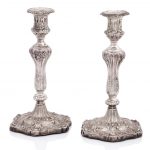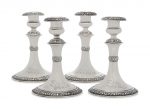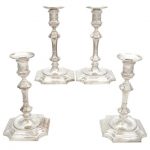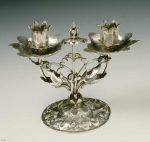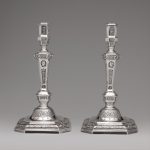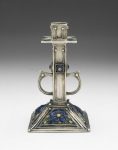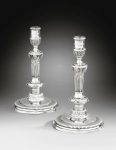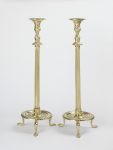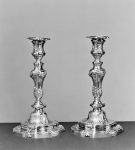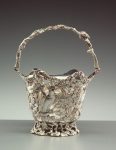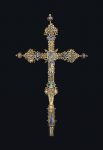Candlesticks. A candlestick, chamberstick, or candelabrum (plural: candelabra) is a device used to hold a candle in place.
The name “candlestick” derives from the purpose of the device as a place to secure or “stick” a burning candle; candlesticks have a cup or a spike (or both in some designs) to keep the candle in place. Webster’s II New College Dictionary defines a candlestick as “an often ornamental holder for securing a candle or candles.” Candlesticks are less frequently called “candleholders”, a word not found in most dictionaries prior to 1960.
Although electric lighting has phased out candles in many parts of the world, candlesticks and candelabra are still used in some Western countries homes as a decorative element or to add atmosphere on special occasions. Before the proliferation of electricity services, candles were brought into the bedroom using chambersticks, which were shorter than ordinary candleholders and furnished with a wide pan to catch the wax drippings. Although not all candlesticks had base pans, it was a common feature on early examples. Reference: Wikipedia
A pair of George III silver candlesticks by J. Roberts & Co., Sheffield 1812 Each on shaped circular base to fluted, knopped column, urn-shaped sockets, and with shell, foliate and anthemion decoration, loaded, height 27cm.
Sold for £ 875 inc. premium at Bonhams in 2018
Pair of candlesticks; silver, cast and hand-raised, with two branches on an elongated, low, oval base. Maker’s marks stamped on the base. Producer name Factory of: Hans Hansen (founded 1906) Designed by: Karl Gustav Hansen (b.1914) Date 1934 (designed) 1947 (made)
Reference: © The Trustees of the British Museum
A SET OF FOUR AMERICAN SILVER CANDLESTICKS MARK OF TIFFANY & CO., NEW YORK, CIRCA 1895 On trumpet form bases, applied with die-rolled bands of cornucopia spaced by shells and scrolls, conforming slip-lock nozzles, bases engraved with foliate script monogram SAS, marked on undersides and numbered 6780-954 8 ¼ in. (21 cm.) 54 oz. 8 dwt. (1,692 gr.)
Sold for USD 7,500 at Christies in 2019
Set of Four American Sterling Silver Candlesticks Peter Guille, New York, 20th century Height 10 inches, weighted.
Sold for $812 (includes buyer’s premium) at Doyle New York in 2019
This candlestick, a fine example of the Parisian goldsmith’s art in the first half of the 17th century, is one of the few known works by François Roberday the elder, goldsmith to the Duke of Orleans. The work was evidently based on the engravings of metalwork designs that goldsmiths used as models. The openwork motifs are typical of the “cosse de pois,” or peapod, style, which was then fashionable among goldsmiths working for the Crown. A candlestick dating from the first half of the 17th century The candlestick has a circular base, made from a sheet of pierced silver, that forms a double openwork rosette of peapod-style ornaments. The central stalk rises from a crown of leaves and is divided into several branches. It terminates in a small handle shaped like a cluster of flowers. On either side are lateral branches that pass through open peapods. Both branches are topped by a candle-ring in the shape of a corolla and a hexagonal candleholder with six petals. Slender tendrils decorated with peapods and peas entwine the main branches. The abundance of leaves and tendrils make this work a typical example of the Parisian goldsmith’s art in the first half of the 17th century.
Reference:The Louvre
These two candlesticks are particularly fine examples of French silver from the close of Louis XIV’s reign. Their decorative vocabulary of interlaced strapwork, foliage, and heads in profile is typical of that found throughout French decorative arts of the late seventeenth century, as is the architectural quality of the design. The various motifs call to mind the works of the court designer Jean Bérain (1640 -1711), whose many prints and drawings influenced the production of ceramics, furniture, wall paneling, and silver well into the eighteenth century. The candlesticks bear the mark of the silversmith known only by the initials I. D., and the Paris warden’s mark of 1690 / 92. This latter mark indicates that the silver content of the candlesticks met the strict guidelines imposed by the guild. Silver in its pure state is too soft to withstand daily use, so small amounts of copper were added for durability. In the late seventeenth century, the Paris standard required that 958.33 parts out of a thousand be pure silver.
Reference: The Metropolitan Museum of Art
Candlestick 1917 Elizabeth Ethel Copeland (American, 1866–1957)
The silver candlestick has a square base, with each side inclining slightly toward a single square column. Each side is decorated with cloisonné enamel decoration of pansy-like flowers and leaves. Concentric circles of blue and yellow enamel form bosses that are placed midway along the length of the column. Geometric wire decoration is applied throughout, surrounding the enameled base and extending along the column shaft; each wire terminates in a spherical ball.
Reference: Museum of Fine Arts Boston
A pair of French silver candlesticks, attributed to Antoine Filassier, Paris, 1717-1718 on circular gadrooned foot, the stem surmounted by four female heads Haut. 23 cm, 1 042 g ; 9 in., 33oz
Sold for 11,250 EUR at Sothebys in 2018
These silver-gilt candlesticks were supplied by the London goldsmith Charles Aldridge in 1787-8. They are based on a Roman bronze lamp stand excavated at Herculaneum in 1737 and acquired from Sir William Hamilton by the British Museum, 1772. They were made for William Beckford (1760-1844), the first European patron to commission deliberately historicising metalwork. They were recorded in the Grand Drawing Room at his home Fonthill Abbey, Wiltshire in 1822. Visitors to Fonthill Abbey commented on the spectacular lighting effects achieved by rows of gilded candlesticks supported on stands at shoulder height.
Each candlestick consists of a detachable fluted stem rising from a fluted plinth of shaped square section, the detachable baluster upper part of the stem and vase-shaped socket are chased with further bands of fluting and varying foliage, the detachable circular wax-pan has fluted and ovolo bands. The stem is supported on three matted claw feet with fluted knees above supporting a broad detachable circular plate chased with palm foliage border and inner bands of arcading and alternate panels of differing formal foliage. Each candlestick is fully marked on the lower plates and part-marked on the reverse of the sockets and on the wax-pans.
Reference: © Victoria and Albert Museum
One of the most influential silversmiths of the mid 18th century, François Thomas Germain (1726-1783) is thought to have introduced this popular model of candlestick in Paris in 1757-1758. Germain also sponsored Lenhendrick’s membership as a master goldsmith in the corporation (goldsmith’s guild) in 1747.
Reference: The Walters Art Museum
